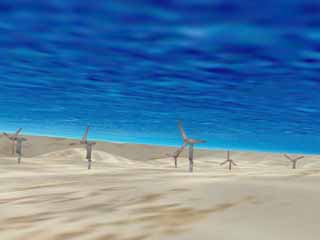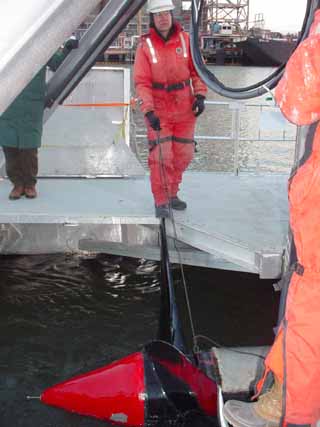
Surveys
DJC.COM
August 3, 2006
Tapping into a sea of power
Devine Tarbell & Associates

Photos courtesy Verdant Power Strong tidal currents can spin underwater turbines to generate electricity. |
Imagine a Puget Sound region with stunning views of Mount Rainier and the Olympic Mountain range, international ship traffic and trade, orca whales, salmon, giant octopus, recreation and underwater turbines capturing the energy from tidal currents to operate our coffee pots and computers.
Puget Sound encompasses some 16,000 square miles of land and water consisting of nine urban counties with over 4 million people. The sound is home to the ports of Seattle and Tacoma, the largest and busiest in Washington.
The population in the greater Puget Sound area is growing and demands for electricity are increasing. Finding new power sources that are environmentally friendly is a challenge. The rhythmic tidal cycle created by the movements of the moon, sun and Earth could represent one new source. The vast kinetic energy of our ocean tides offers opportunity to harness pollution-free power.
Scientists and regulatory experts at Devine Tarbell & Associates have been working with Tacoma Power, the Electric Power Research Institute (EPRI), Verdant Power and others to evaluate various environmental and regulatory aspects of tidal energy sites and projects in the United States, including in the Tacoma Narrows.
EPRI recently completed assessments of several locations where deployment of tidal in-stream power plants may be feasible and concluded that the Tacoma Narrows shows promise. Tacoma Power is assessing the potential of installing a series of turbines near the Tacoma Narrows Bridge and has received a preliminary permit from the Federal Energy Regulatory Commission for a pilot project.
Tacoma Narrows is a strait where the tides generate high water velocities, which could be transformed into electricity. Puget Sound as a whole is relatively deep (approximately 750 feet) and wide (approximately 4 miles), whereas the Tacoma Narrows is shallow (approximately 138 feet) and narrow (approximately 1 mile wide). The strongest tidal currents are observed near Point Evans, averaging 3.9 feet per second.

Verdant Power later this year will install turbines below the surface of New York's East River.
|
Devine Tarbell is working with Verdant Power to deploy the first tidal energy project in the United States, in the East River of New York City. Assessments of potential effects on fish and wildlife are under way using a variety of specialized equipment, including hydrophones for underwater noise measurement, echo sounding equipment to monitor fish, and acoustic Doppler technology to assess water velocity changes.
Verdant is planning to deploy underwater turbines in the East River later this year. The pilot project calls for six turbines, with two to be installed initially. They will be smaller in scale to those proposed in Tacoma, and will be used to create 200 kilowatts of power for a local supermarket and parking garage. If the test is successful, up to 300 turbines could be installed in the East River, which could power 8,000 homes.
Tidal energy resources are vast and when captured can serve as another renewable source of clean electricity with no greenhouse gas emissions. Tidal power characteristically holds several advantages to other alternative energy sources, such as wind. The density of energy within water is significantly higher than in air. Tidal energy production also is predictable, requires minimal space and has little to no visual impact.
Many tidal power generators are designed to be submerged, leaving navigable channels unimpeded and scenic areas untainted.
Pilot projects and site evaluations, such as Verdant’s project in New York and the Tacoma Narrows site assessment in Washington, are creating a path for tidal power in the United States. The next few years will be the testing grounds for pilot projects and feasibility studies and the results will help define tidal power’s role in our energy-dependent society.
Paul Szewczykowski is the Northwest region environmental services manager in Devine Tarbell & Associates’ Bellingham office.
Other Stories:
- Mechanical engineers hop aboard the green bandwagon
- States keep their authority to regulate dams
- UW’s environmental strategy goes from grass roots to daily integration
- New rules for ‘innocent landowners’
- Washington banks on wetland mitigation
- Navigating our water right application process
- Orcas: the next killer environmental issue?
- Minimize data handling to reduce errors
- Solvent spill? Know your cleanup options
- Fish to fly past the ‘Kirkland crawl’
- Getting the creosote out of Puget Sound
- Green Factor would change urban landscape design
- Spokane does brownfields on a grand scale
- Plan ahead for the new stormwater permit
- Local environment benefits from oil spill
- Conservation program saves money, landfill space
- Education centers show how to tread lightly on the environment
Copyright ©2009 Seattle Daily Journal and DJC.COM.
Comments? Questions? Contact us.